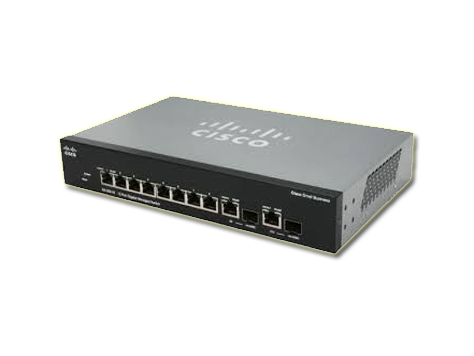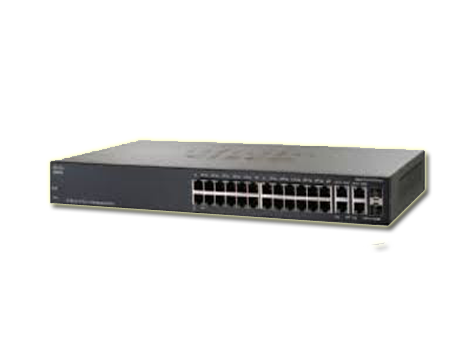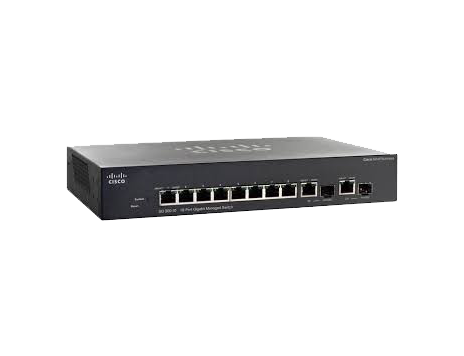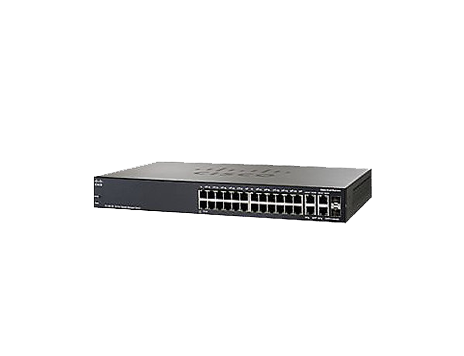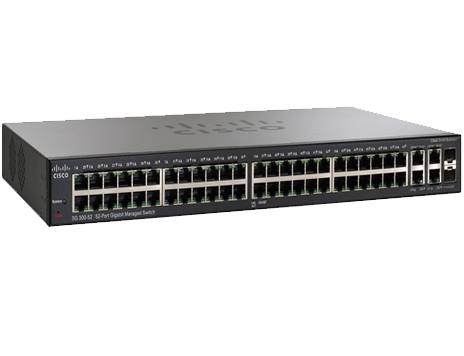SF300-24PP 24-port 10/100 PoE+ (Total : 180W / 24 Port) Managed Switch w/Gig Uplinks
● 24 10/100 PoE+ ports with 180W power budget
● 2 10/100/1000 ports
● 2 combo mini-GBIC ports
Layer 2 Switching
Spanning Tree Protocol (STP)
Standard 802.1d Spanning Tree support
Fast convergence using 802.1w (Rapid Spanning Tree [RSTP]), enabled by default
8 instances are supported
Multiple Spanning Tree instances using 802.1s (MSTP)
Port grouping
Support for IEEE 802.3ad Link Aggregation Control Protocol (LACP)
● Up to 8 groups
● Up to 8 ports per group with 16 candidate ports for each (dynamic) 802.3ad link aggregation
VLAN : Support for up to 4096 VLANs simultaneously Port-based and 802.1Q tag-based VLANs MAC-based VLAN
Management VLAN
Private VLAN Edge (PVE), also known as protected ports, with multiple uplinks
Guest VLAN Unauthenticated VLAN
Dynamic VLAN assignment via Radius server along with 802.1x client authentication
CPE VLAN
Voice VLAN : Voice traffic is automatically assigned to a voice-specific VLAN and treated with appropriate levels of QoS.
Auto voice capabilities deliver network-wide zero touch deployment of voice endpoints and call control devices.
Multicast TV VLAN : Multicast TV VLAN allows the single multicast VLAN to be shared in the network while subscribers remain in separate VLANs (Also known as MVR)
Q-in-Q VLAN : VLANs transparently cross a service provider network while isolating traffic among customers
Generic VLAN Registration Protocol (GVRP)/Generic Attribute Registration Protocol (GARP)
Protocols for automatically propagating and configuring VLANs in a bridged domain
Unidirectional Link Detection (UDLD)
UDLD monitors physical connection to detect unidirectional links caused by incorrect wiring or cable/port faults to prevent forwarding loops and blackholing of traffic in switched networks
Dynamic Host Configuration Protocol (DHCP) Relay at Layer 2
Relay of DHCP traffic to DHCP server in different VLAN. Works with DHCP Option 82
Internet Group Management Protocol (IGMP) versions 1, 2, and 3 snooping
IGMP limits bandwidth-intensive multicast traffic to only the requesters; supports 1K multicast groups (source-specific multicasting is also supported)
IGMP Querier : IGMP querier is used to support a Layer 2 multicast domain of snooping switches in the absence of a multicast router
Head-of-line (HOL) blocking : HOL blocking prevention
Jumbo Frames : Up to 9K (9216) bytes
Layer 3
IPv4 routing : Wirespeed routing of IPv4 packets
Up to 512 static routes and up to 128 IP interfaces
Classless Inter-Domain Routing (CIDR)
Support for CIDR
Layer 3 Interface : Configuration of layer 3 interface on physical port, LAG, VLAN interface or Loopback interface
DHCP relay at Layer 3
Relay of DHCP traffic across IP domains
User Datagram Protocol (UDP) relay : Relay of broadcast information across Layer 3 domains for application discovery or relaying of BootP/DHCP packets
DHCP Server : Switch functions as an IPv4 DHCP Server serving IP addresses for multiple DHCP pools/scopes
Support for DHCP options


